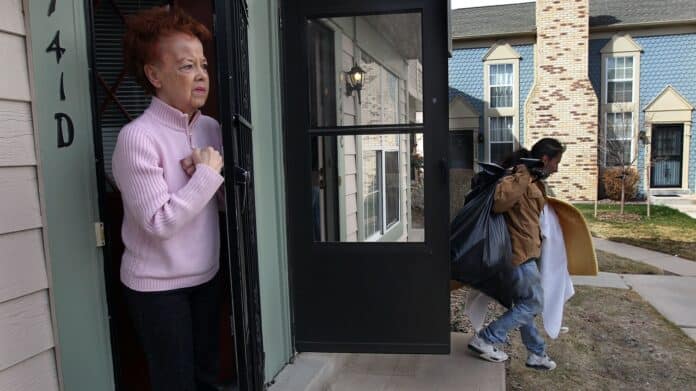
Due in part to bureaucratic delays at state and local levels, however, less than 40% of that money had been spent as of the end of January 2022 – and in much of the country, a large share of the population is behind on rent and facing possible eviction.
According to data collected between Jan. 26, 2022 to Feb. 7, 2022 by the U.S. Census Bureau’s Household Pulse Survey, about 4.4 million Americans agreed that they were either “somewhat likely” or “very likely” to have to leave their home within the next two months due to eviction. That amounts to 43.4% of the 10.1 million renters nationwide who are behind on rent payments.
Minnesota is home to some 99,110 renters who owe their landlords rent, and an estimated 29.5% of them reported being either somewhat likely or very likely to face eviction in the coming months – the 13th smallest share among states.
Many of those at risk of losing their home are not confident that they can afford to make future rent payments. Some are also burdened with multiple months of debt from back rent. A reported 24,408 renters in the state – or 24.6% of all renters with some rental debt – are three months behind or more on their rent. For context, 26.2% of renters nationwide who owe back rent are three months behind or more.
| Rank | State | Somewhat or very likely to leave home due to eviction (% of all renters who owe back rent) | Renters who owe back rent and are 3 or more months behind on rental payment (%) | Renters who owe any back rent in state |
|---|---|---|---|---|
| 1 | Utah | 67.1 | 24.5 | 30,370 |
| 2 | Alabama | 65.8 | 22.9 | 133,160 |
| 3 | Louisiana | 63.4 | 22.7 | 110,640 |
| 4 | Pennsylvania | 63.1 | 31.3 | 299,730 |
| 5 | Wisconsin | 61.5 | 37.4 | 172,740 |
| 6 | Maine | 60.3 | 16.3 | 30,810 |
| 7 | Idaho | 59.4 | 19.4 | 22,840 |
| 8 | Texas | 57.4 | 24.7 | 634,480 |
| 9 | Georgia | 55.2 | 25.5 | 259,920 |
| 10 | Wyoming | 55.0 | 42.6 | 18,750 |
| 11 | Ohio | 54.7 | 16.9 | 233,870 |
| 12 | Illinois | 52.1 | 26.7 | 495,440 |
| 13 | Arkansas | 49.7 | 33.5 | 96,440 |
| 14 | New Jersey | 48.6 | 29.7 | 393,100 |
| 15 | Oklahoma | 47.9 | 21.2 | 169,000 |
| 16 | California | 46.9 | 27.1 | 1,592,050 |
| 17 | New Mexico | 46.5 | 31.8 | 57,040 |
| 18 | Michigan | 46.0 | 34.7 | 283,270 |
| 19 | Nebraska | 45.0 | 9.3 | 39,070 |
| 20 | Maryland | 44.4 | 43.1 | 200,850 |
| 21 | South Carolina | 44.4 | 43.6 | 179,130 |
| 22 | Mississippi | 42.9 | 59.1 | 139,000 |
| 23 | West Virginia | 42.2 | 31.1 | 47,680 |
| 24 | Florida | 40.9 | 15.0 | 608,570 |
| 25 | North Carolina | 40.2 | 26.9 | 211,820 |
| 26 | Tennessee | 39.6 | 20.2 | 142,980 |
| 27 | Arizona | 38.3 | 15.0 | 168,170 |
| 28 | Oregon | 38.0 | 34.6 | 111,530 |
| 29 | New York | 37.7 | 25.8 | 1,303,390 |
| 30 | New Hampshire | 36.2 | 32.2 | 24,700 |
| 31 | Montana | 35.7 | 18.3 | 24,230 |
| 32 | Massachusetts | 34.5 | 13.4 | 229,090 |
| 33 | Kentucky | 33.0 | 36.9 | 78,230 |
| 34 | Kansas | 31.7 | 9.7 | 65,470 |
| 35 | Washington | 31.6 | 21.3 | 190,740 |
| 36 | North Dakota | 31.3 | 16.8 | 25,460 |
| 37 | South Dakota | 30.9 | 53.4 | 22,750 |
| 38 | Minnesota | 29.5 | 24.6 | 99,110 |
| 39 | Indiana | 28.2 | 11.6 | 184,730 |
| 40 | Virginia | 24.1 | 8.2 | 211,290 |
| 41 | Nevada | 24.1 | 51.3 | 156,530 |
| 42 | Vermont | 22.5 | 41.0 | 7,420 |
| 43 | Rhode Island | 22.4 | 19.0 | 34,840 |
| 44 | Missouri | 20.4 | 31.0 | 203,720 |
| 45 | Colorado | 19.2 | 16.3 | 77,920 |
| 46 | Connecticut | 19.2 | 33.2 | 120,370 |
| 47 | Hawaii | 19.1 | 12.9 | 70,410 |
| 48 | Delaware | 14.2 | 28.2 | 25,180 |
| 49 | Iowa | 11.7 | 29.9 | 44,470 |
| 50 | Alaska | 10.5 | 31.3 | 12,640 |


